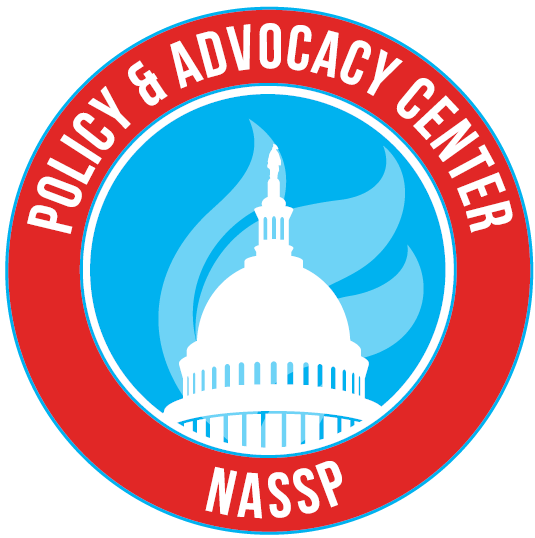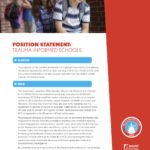The purpose of this position statement is to highlight how trauma and adverse childhood experiences affect student learning and school climate and to offer policy recommendations to help support educators as they seek to create trauma-informed schools.
The most recent data from Child Trends indicate that 45 percent of children in the United States have experienced at least one adverse childhood experience (ACE) that could be trauma-inducing such as abuse or neglect, violence, discrimination, bullying, natural disasters, or death of a loved one. However, the two most common ACEs are economic hardship and the separation or divorce of parent or guardian. Nationwide, 61 percent of black children and 51 percent of Hispanic children have experienced at least one ACE compared to only 40 percent of their white peers.

Physiological changes to children’s brains as well as emotional and behavioral responses to trauma have the potential to interfere with children’s learning, school engagement, and academic success—even years after the trauma took place. Researchers have also identified a “cycle of trauma” in schools when teachers’ rules and consequences are viewed as punishment by children, increasing the likelihood of retraumatization and exclusionary discipline practices. Schools with higher incidents of ACEs also have higher rates of suspensions and unexcused absences and lower graduation rates and postsecondary participation.
By understanding and responding to trauma and acknowledging the potential impacts of stress and adversity, school administrators, teachers, and staff can help reduce its negative impact, support critical learning, and create a more positive school environment. Trauma-informed schools can help children and adults overcome trauma and build resilience by helping educators be responsive to the needs of their students with “seamless, accessible social, behavioral, and emotional supports involving all school community members, as well as access to evidence-based, developmentally appropriate, child and family services,” according to the National Child Traumatic Stress Network.
Guiding Principles
- Building Ranks™: A Comprehensive Framework for Effective School Leaders translates new educational leadership standards into an actionable framework that promotes the academic, social, emotional, and physical success of each student by building culture and leading learning.
- The 2015 Professional Standards for Educational Leaders (PSEL) state that effective leaders cultivate an inclusive, caring, and supportive school community that promotes the academic success and well-being of each student.
- NASSP has previously adopted position statements on school discipline and culturally responsive schools in order to offer recommendations for policymakers and school leaders to promote student equity and help each student achieve their greatest potential.
- Effective school leaders set the conditions for trauma-informed schools by engaging all staff in the process, incorporating trauma-informed practices and strategies into other strategic planning efforts and school initiatives, helping teachers integrate trauma-informed routines into their classroom activities, and ensuring schools address secondary traumatic stress that may affect teachers and other staff.
Recommendations
Recommendations for Federal Policymakers
- Create a technical assistance center at the U.S. Department of Education to assist states and districts in creating trauma-informed schools.
- Conduct research on the impact of trauma on all members of the school community and how it affects student and adult behavior in schools and disseminate best practices on how schools and educators can address the needs of children and educators affected by trauma.
- Increase funding for Title II of the Elementary and Secondary Education Act, which may be used by school districts to provide in-service training for school personnel on how to refer students affected by trauma, the use of referral mechanisms that effectively link such children to appropriate treatment and intervention services in the school and the community, and form partnerships between schools and mental health providers.
- Adopt legislation to define “trauma-informed practices” and require state plans under the Every Student Succeeds Act to address how states and districts will support efforts to increase the prevalence of trauma-informed practices in schools.
- Provide funding to assist schools in recruiting and retaining school counselors, social workers, and psychologists to support school-based interventions and the coordination of services.
- Authorize legislation to assist schools in offering social and emotional learning and positive behavior interventions and supports.
Recommendations for State Policymakers
- Establish grant programs to support schools in implementing trauma-informed practices and developing schoolwide action plans to address the needs of children affected by trauma, and offer professional learning opportunities statewide for educators on evidence-based trauma-informed practices.
- Provide funding for trauma counselors to assist students and educators who experience a schoolwide trauma-inducing event such as a school shooting, natural disaster, or death of student or staff member.
- Adopt or adapt the PSEL to ensure that principal certification and licensure requirements include a focus on community of care and support for students.
- Encourage preparation programs for school leaders, teachers, and school counselors to include training on the impact of trauma on students’ academic, behavioral, and social development, and how educators can help support and effectively educate these students.
Recommendations for District Leaders
- Implement multitiered systems of support that encompass prevention, wellness promotion, and interventions that are based on student need and promote close school-community collaboration.
- Focus on prevention and effective interventions as responses to disciplinary issues, including Positive Behavioral Interventions and Supports, social and emotional learning, peer juries, restorative justice processes, diversion, mentoring, mental health counseling, restitution, and community service programs.
- Provide professional learning for principals and other school staff to build awareness and sensitivity about trauma, recognize the warning signs of trauma in children, know when and how to refer students for community-based services, and document and evaluate the effectiveness of prevention and intervention programs.
- Utilize the Building Ranks framework to help principal develop their leadership skills to focus on community of care and support for students.
- Ensure schools have adequate staffing to provide students with sustained counseling or other mental health services; assist children and families in accessing community-based services; and create an effective infrastructure to implement trauma-informed policies, practices, and procedures.
- Develop protocols to obtain trauma histories or other pertinent information for transfer students and student who are new to the school.
Recommendations for School Leaders
- Ensure all school staff, including janitors, cafeteria workers, and administrative assistants participate in professional development opportunities to implement a multitiered system of support where all students receive Tier 1 supports.
- Help clarify roles and responsibilities of teachers in acknowledging and recognizing the potential impacts of stress and trauma on student learning, interacting with students affected by trauma, ensuring a balance between maintaining normal classroom routines and giving special attention to students affected by trauma, and when and how to refer students for additional mental health supports.
- In situations where multiple students and staff have experienced a traumatic event such as a school shooting or natural disaster, lead recovery efforts and plan for commemorations or other similar events that could trigger post-traumatic stress.
- Review discipline policies and student code of conducts to ensure they reflect an understanding of how trauma may affect student behaviors and whether or not they address resilience, hope, and the skills needed by students to function both in and out of the classroom.
- Practice mindfulness and seek support and counseling for yourself and your staff to prevent “compassion fatigue” or secondary traumatic stress.
Resources
American School Counselor Association (2017). Transforming schools with trauma-informed care. Retrieved from https://www.schoolcounselor.org/asca/media/asca/ASCAU/Trauma-Crisis-Management-Specialist/TransformingSchools.pdf.
Child Trends (2018). The prevalence of adverse childhood experiences, nationally, by state, and by race or ethnicity. Retrieved from https://www.childtrends.org/publications/prevalence-adverse-childhood-experiences-nationally-state-race-ethnicity.
Education Law Center (2015). Unlocking the door to learning: Trauma-informed classrooms & transformational schools. Retrieved from https://www.elc-pa.org/wp-content/uploads/2015/06/Trauma-Informed-in-Schools-Classrooms-FINAL-December2014-2.pdf.
Futures Without Violence (2015). Safe, healthy, and ready to learn: Policy recommendations to ensure children thrive in supportive communities free from violence and trauma. Retrieved from https://s3.amazonaws.com/fwvcorp/wp-content/uploads/20160125133319/Safe-Healthy-Ready-to-Learn_1.2016.pdf.
Keystone Learning Services (2018). School building leadership’s role in creating a trauma-sensitive school. Retrieved from https://www.keystonelearning.org/school-building-leaderships-role-in-creating-a-trauma-sensitive-school-trauma-sensitive-schools/.
Massachusetts Advocates for Children: Trauma and Learning Policy Initiative (2005). Helping traumatized children learn. Retrieved from https://traumasensitiveschools.org/wp-content/uploads/2013/06/Helping-Traumatized-Children-Learn.pdf.
National Association of School Psychologists (2016). Creating trauma-sensitive schools. Retrieved from https://www.nasponline.org/resources-and-publications/resources-and-podcasts/mental-health/trauma-sensitive-schools.
National Association of School Psychologists (2015). Preventing childhood trauma: Guidelines for administrators and crisis teams. Retrieved from https://www.nasponline.org/resources-and-publications/resources-and-podcasts/school-climate-safety-and-crisis/mental-health-resources/trauma/preventing-childhood-trauma-guidelines-for-administrators-and-crisis-teams.
National Association of Secondary School Principals (2018). Building ranks: A comprehensive framework for effective school leaders. Reston, VA: Author.
National Association of Secondary School Principals (2019). From trauma aware to trauma responsive. Retrieved from http://blog.nassp.org/2019/05/21/from-trauma-aware-to-trauma-responsive/.
National Center for School Crisis and Bereavement. Retrieved from https://www.schoolcrisiscenter.org/
National Policy Board for Educational Administration (2018). National educational leadership preparation standards: Building level. Retrieved from http://npbea.org/wp-content/uploads/2018/11/NELP-Building-Standards.pdf.
National Child Traumatic Stress Network Schools Committee (2008). Child trauma toolkit for educators. Los Angeles, CA, and Durham, NC: National Center for Child Traumatic Stress.
National Child Traumatic Stress Network Schools Committee (2017). Creating, supporting, and sustaining trauma-informed schools: A system framework. Los Angeles, CA, and Durham, NC: National Center for Child Traumatic Stress.
Sparks, S. (2019). Prepping schools for emotional effects of disaster. Education Week. Vol. 39. Issue 1.
Terrasi, S. & Crain, P. (2017) Trauma and learning in America’s classrooms. Phi Delta Kappan 98(6), 35–41. Retrieved from https://www.kappanonline.org/trauma-classrooms-learning/

